Betty Balfour (1903-1977) was a gamine-like silent screen star, nicknamed the ‘British Mary Pickford’. She was a great mimic who started in Music Hall and became known as ‘Britain's Queen of Happiness’. During the 1920s, Balfour was Britain’s most popular actress.

French postcard by Cinémagazine Edition, no. 84. Photo: Maull & Fox.
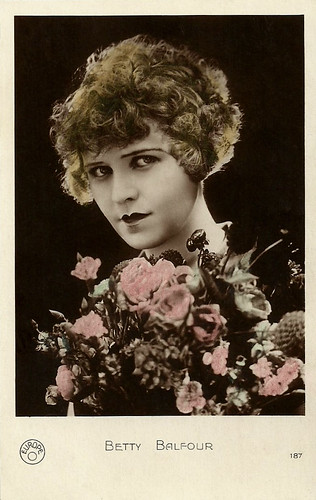
French postcard by Europe, no. 187.
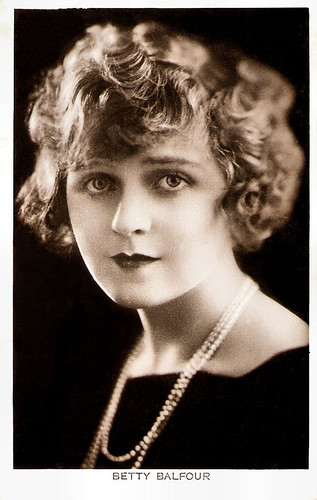
British postcard by Real Photograph.
Comic charm
Betty Balfour was born in London, Great Britain, in 1903. She made her stage debut at the age of 10 (in 1913 or 1914 – the sources differ) at the Court Theatre and she became one of C. B. Cochran's stars.
Years later, when she was appearing in 'Medora' at the Alhambra Theatre, filmmakers T. A. Welsh and George Pearson saw her and were impressed by Balfour’s delicate expression and comic charm. They signed her for her film debut in Nothing Else Matters (George Pearson, 1920) with Hugh E. Wright. Betty instantly showcased her comic talents. After replacing Gertrude Lawrence on stage in 'The Midnight Follies', Balfour was back with Pearson for her first starring role in Mary-Find-the-Gold (George Pearson, 1921).
It was her role as the wayward florist Squibs Hopkins in Squibs (George Pearson, 1921) that established Balfour as a national star, creating a persona that would both propel and restrict her career. Squibs is a cockney flower girl working at Piccadilly Circus, and this proved to be the ideal vehicle for Balfour’s cheerful disposition, amidst a dreary London setting. The instant success of the film lead to three sequels, Squibs Wins the Calcutta Sweep (George Pearson, 1922), Squibs M.P. (George Pearson, 1923) and Squibs’ Honeymoon (George Pearson, 1923).
In the Encyclopedia of British Film, Brian McFarlane calls Balfour "a great mimic". At the beautiful website Women and British Silent Cinema, Dan Horn writes that "it was this refreshing charisma, typified in Squibs, which made Balfour an icon of the silent era". Horn quotes film historian Rachael Low, who comments that Balfour was "able to register on screen a charm and expression unequalled among the actresses in British film".
In the more gritty productions Love, Life and Laughter (George Pearson, 1923) and Reveille (George Pearson, 1924), she demonstrated a more serious side to her character. When Betty rejected Pearson's offer to divorce his wife and marry hér, her professional partnership with Welsh-Pearson ended. Their final film together was Blinkeyes (George Pearson, 1926).
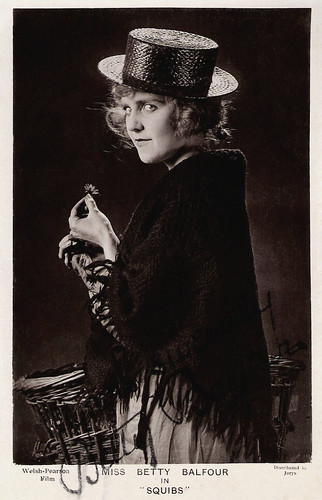
British postcard by Jurys. Photo: Welsh-Pearson Film. Still from Squibs (1921).
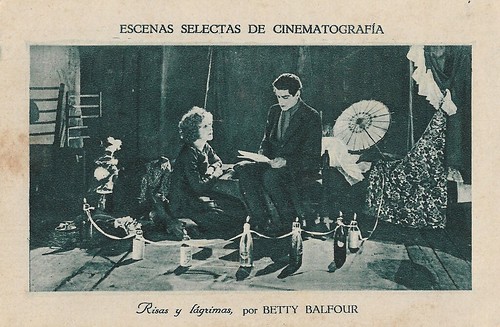
Spanish minicard (collector's card) by Escenas selectas de cinematografia, series A, no. 15. Betty Balfour (Tip-Toes) and Harry Jonas (the Boy) in Love, Life and Laughter (George Pearson, 1923), released in Spain as Risas y lagrimas (Laughter and Tears).

Spanish minicard (collector's card) by Escenas selectas de cinematografia, series B, no. 8. Betty Balfour in Love, Life and Laughter (George Pearson, 1923), released in Spain as Risas y lagrimas (Laughter and Tears).
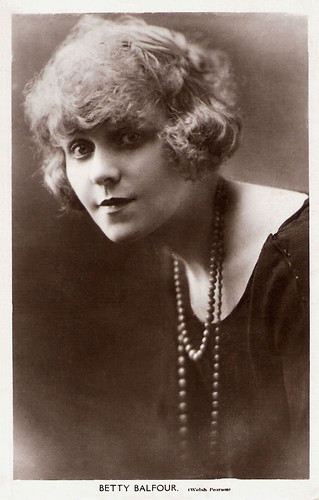
British postcard in the Picturegoer Series, London, no. 2. Photo: Welsh-Pearson Film.

British postcard in the Picturegoer Series, London, no. 226. Sent by mail in Great Britain in 1928. Photo: Balfour Welsh Pearson.
The country's favourite world star
At the time, Betty Balfour was the most popular actress in Britain, and in 1927 the newspaper Daily Mirror named her as the country's favourite world star. The popular Squibs films, and an array of product endorsements, ensured that Balfour’s vast fan base had flourished.
Balfour made no attempt to break into Hollywood but like Ivor Novello, she was able to export her talents to mainland Europe. She starred in the German films Die sieben Töchter der Frau Gyurkovics/A Sister of Six (Ragnar Hylten-Cavallius, 1926) with Willy Fritsch, and Die Regimentstochter/Daughter of the Regiment (Hans Behrendt, 1929), in the French films La Petite Bonne du Palace/The Little Maid at the Palace (Louis Mercanton, 1926), Le Diable au Coeur/Little Devil May Care (Marcel L'Herbier, 1927) with Jaque Catelain, and Croquette (Louis Mercanton, 1927), and in the Austrian-British production Champagner/Bright Eyes (Géza von Bolváry, 1929) with Jack Trevor.
In these films, she re-established herself as a sophisticated, fashionable woman of the world, far removed from the persona that had typecast her. Consequently, her popularity in Britain began to decline. Back in Britain, she featured successfully in Alfred Hitchcock's comedy Champagne (1928), but Balfour's sound debut The Nipper/The Brat (Louis Mercanton, 1930), based on the Squibs character, was only moderately successful.
Her popularity diminished in the 1930s, and Balfour began to struggle for leading roles. She only played a supporting role to Jessie Matthews in Evergreen (Victor Saville, 1934) and appeared with John Mills in Brown on Resolution/Forever England (Walter Forde, 1935). Even a musical remake of Squibs (Henry Lawson, 1935) with Stanley Holloway was unable to recapture her former popularity.
In 1945, after a nine-year hiatus, Balfour appeared in 29 Acacia Avenue (Henry Cass, 1945) starring Gordon Harker. This was to be her final film. 'Britain's Queen of Happiness' was not happy in her private life. After a stage comeback failed in 1952, she attempted suicide. For the last 20 years of her life, she was a recluse. At age 74, Betty Balfour died in 1977 or 1978 (the sources differ), in Weybridge, England. She had been married once, to composer Jimmy Campbell from 1931 till their divorce in 1941. They had one child.
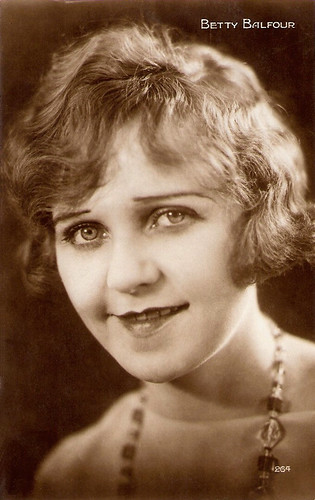
French postcard by Cinémagazine Edition, no. 264.
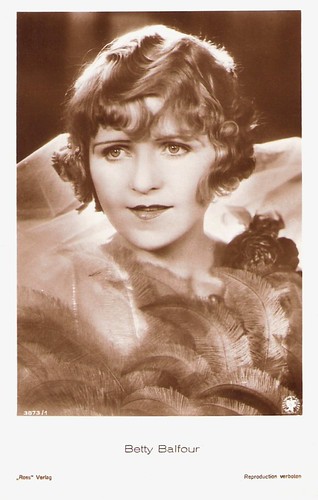
German postcard by Ross Verlag, no. 3873/1, 1928-1929. Photo: Imperial Film.

German postcard by Ross Verlag, no. 3572/1, 1928 - 1929. Photo: Imperial Film.
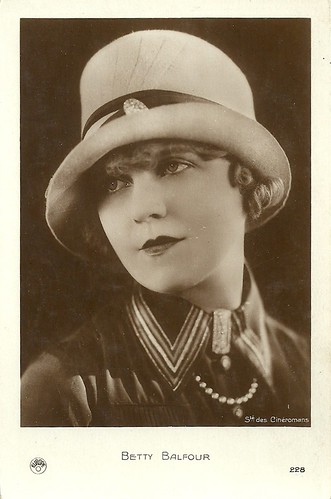
French postcard by Europe, no. 228. Photo: Société des Cinéromans.

Austrian postcard by Iris Verlag. Photo: Sascha Film, Vienna.
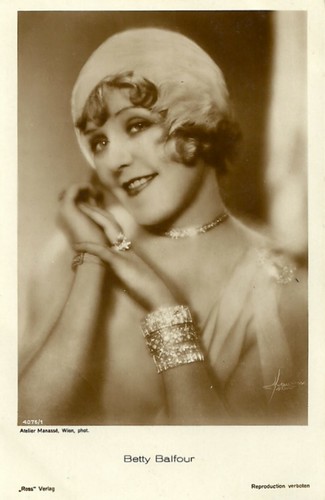
German postcard by Ross Verlag, no. 4076/1, 1929-1930. Photo: Atelier Manassé, Vienna.
Sources: Brian McFarlane (Encyclopedia of British Film), Dan Horn (Women and British Silent Cinema), Wikipedia, and IMDb.
This post was last updated on 1 May 2023.
No comments:
Post a Comment